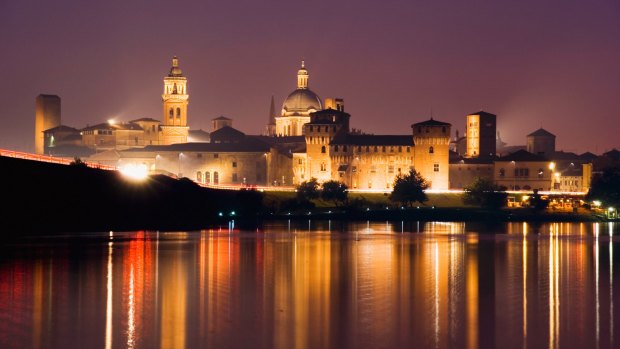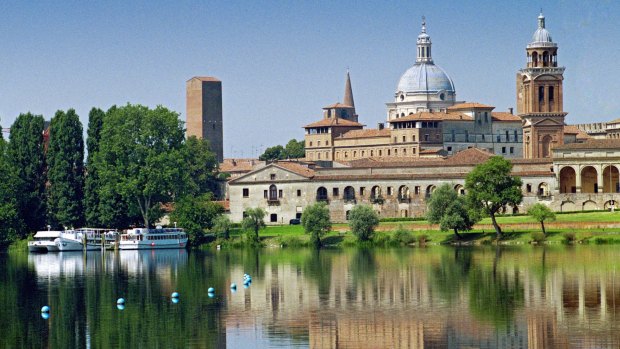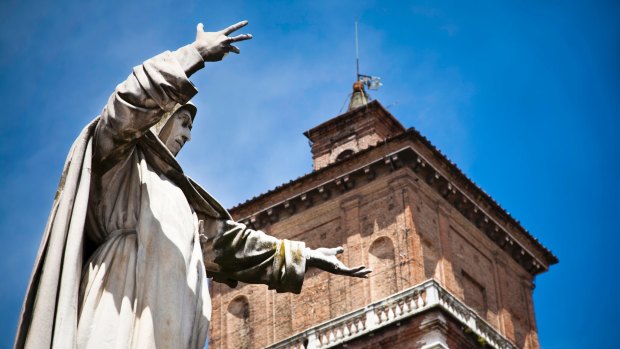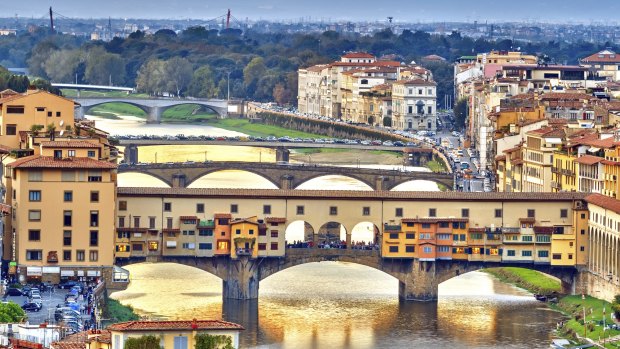This was published 7 years ago
Italy's most overlooked renaissance city-states: Where art was used for power and influence
By Ute Junker
Federico II Gonzaga, Duke of Mantua, loved horses. So when he asked Giulio Romano to build him a new showpiece palace in 1524, the instructions were precise. The elaborate frescoes that would cover virtually every inch of the interior were to feature not just romping gods and goddesses – the favoured motif for domestic Renaissance art – but also some imposing steeds.
Which is why, when visitors to Mantua wander into the main reception hall of the sumptuous Palazzo Te, they come face to face with lovingly drawn portraits of Federico's favourite horses, Dario, Glorioso, Battaglia and Morel Favorito.
These weren't just any horses, of course. The Gonzaga of Mantua made their fortune as condottiere, leaders of mercenary troops, and the warhorses that they bred were an essential part of their success. So admired were the Gonzaga horses that the Holy Roman Emperor Charles V was thrilled to receive one as a gift. It is even possible that the Gonzaga family's elevation from marquis status to dukedom, a promotion conferred by the emperor, was linked with that smart bit of horse trading.

Cityscape of Mantua at night.Credit: Charles Bowman
These days, Duke Federico is remembered less as a horse breeder and more as an artistic patron, thanks in part to Palazzo Te. Considered one of the most exquisite examples of Renaissance architecture, the palazzo became famous across Europe for its ornately decorated rooms. More than just a stunning artistic achievement, however, the building was also a statement of power.
THE ART OF INFLUENCE
During the Renaissance, art was one of the tools that rulers of city-states used to help shore up their authority. "The ability to deploy large numbers of important artists was a way of showing the power and status of a ruler," Professor Fabrizio Nevola says.

Mantua's Old Town.Credit: Riccardo Sala
Nevola, a specialist in the urban and architectural history of early modern Italy, is leading our "Courts of Northern Italy" tour through Martin Randall Travel, the UK-based cultural tour specialists. The itinerary takes in cities which are overlooked by many visitors: places such as Mantua, Ferrara, Parma, Ravenna and Urbino.
Less well known than heavy hitters such as Florence and Venice, these were nonetheless powerful city-states whose rulers used art as a form of propaganda. Yet there are few museum visits on this tour. Instead, we wander through churches and palaces and private apartments, where we see magnificent art works as they were originally meant to be seen.
Walking through the Palazzo Te, from one brilliantly decorated room to another – from the Hall of the Horses to the banqueting hall, with its sensual frescoes depicting the love story of Amor and Psyche – it is hard not to feel awed: precisely the effect that Duke Federico had intended.

A castle of the Este dynasty in Ferrara.Credit: Jessica Morelli
None of Palazzo Te's rooms is more striking than the Chamber of the Giants. Every inch of the chamber's ceilings and walls is covered with vivid frescoes that tell the story of the giants being evicted from Olympus after rebelling against Jupiter. The chief god is unleashing his considerable powers, hurling lightning bolts and a rain of rocks.
Romano's accomplished use of perspective and his unrestrained violence – columns and boulders collapse all around the spectators, as twisted and crushed bodies fall onto jagged rocks – make the viewer feel as if they too are under attack. Romano even scattered pebbles on the floor and included a fireplace in the room; the noise of the stones and the heat and colour of the flames created a Renaissance version of a sound and light show.
POWER PLAYS

Bridges over Arno river at sunset, Florence, Italy.Credit: iStock
In many ways, the Gonzaga of Mantua were typical of the rulers of their time. Like many of their rivals, they literally fought their way to the top, hiring out their soldiers to larger cities in the never-ending wars that roiled the area. They also invested heavily in art.
Over several generations, the Gonzaga proved to have a real eye for talent. Federico's grandson, Vincenzo, had the likes of the painter Rubens and the composer Monteverdi at his court. Vincenzo also amassed an astonishing art collection. One of his best buys was a canvas by up-and-coming painter Caravaggio, which had been rejected as too controversial by the client who had commissioned it.
By the 17th century, when the clan hit hard times and started selling their most valuable assets, the family art collection was believed to include more than 2000 paintings and more than 20,000 bronzes, marbles, ceramics, manuscripts and other treasures.
The immense prestige of the Mantuan Gonzaga inspired other branches of the family, most notably a distant relative called Vespasiano Gonzaga. Vespasiano may be forgiven for having a chip on his shoulder. After he was orphaned at a young age, the aunt who had been appointed his guardian fled with the young Vespasiano to Naples, after members of his mother's family tried to kill him to get the lands he had inherited.
Vespasiano's luck changed when he was sent to be educated at the Spanish royal court, where he later became an adviser to the emperor and was showered with titles. When he was named a duke, Vespasiano was finally on the same social level as his famous relatives in Mantua.
There is no point in being a duke, however, if you don't have a city to rule over, so Vespasiano decided to build a base of his own. Choosing a location near Parma, he took just 40 years to create Sabbioneta which – despite its compact size – was hailed as the embodiment of the perfect Renaissance city.
FRESCOES AND FORTRESSES
The first thing you notice about Sabbioneta it its mighty walls. As an experienced military commander, Vespasiano knew a thing or two about cities, and built his star-shaped fortifications thick enough to withstand cannon fire. As a back-up measure, although the rest of the city is on a Roman-inspired grid plan, the streets leading to the gates are laid out at odd angles and with unexpected bends, creating a maze to trap invaders.
Having ensured his city was defensible, Vespasiano's next priority was that other princely prerequisite: an art collection. The duke quickly amassed a renowned collection which, according to contemporary sources, contained more than 2000 statues and art works. Some pieces were bought from antique dealers; others were carried away as booty during the Sack of Rome, which Vespasiano and his troops took part in.
The collection was displayed in the Galleria degli Antichi, a grand corridor almost 100 metres long and six metres wide. Sadly, the art works are long gone, and while the scale of the corridor is impressive, the frescoes that decorate it are not. Much more appealing is the adjoining Palazzo Giardino, where the vividly frescoed walls mingle classical motifs with catalogues of wild animals such as rhinos, lions and elephants.
An art collection was a standard accessory for a Renaissance ruler, but Vespasiano wanted to stand out from the crowd. As his showpiece, he constructed something quite remarkable: the first freestanding, purpose built theatre of the time. The Teatro all'Antica is still impressive today, particularly its permanent stage set, which depicts the streets of Sabbioneta.
TALES OF THE CITY
Vespasiano was not the only ruler to dream of creating of his perfect city.
"Around this time, the idea of the court artists takes off, and you see the look of a city created and curated by one artist," Nevola says. One of the most spectacular examples is the town of Urbino, the design of which was heavily influenced by the Duke of Montefeltro's favourite artist, Francesco di Giorgio.
When UNESCO gave the town's historic centre a World Heritage listing, it was described as "a pinnacle of Renaissance art and architecture". One of the most remarkable things about Urbino is the fact that the duke's palace lies open to the town, a sure sign that the ruler revelled in the support of his subjects.
Not every ruler was so fortunate. Take the d'Este family of Ferrara. They may rank among the great cultural patrons of the Renaissance, but one look at Ferrara's castle – a bulky, heavily defended fortress – makes it clear that the citizens of Ferrara were not always enthusiastic supporters of the clan that ruled them.
The d'Estes also tried their hand at city building, with Duke Ercole adding a large new district that effectively doubled the size of Ferrara. However, that doesn't seem to have helped win over the populace. The family headquarters in the new district still have a decidedly defensive appearance. The building is made up of 8500 marble blocks, each of which has a pointed tip, making the building – known as the Palazzo dei Diamanti – appear to bristle like a hedgehog.
Although most of the great Renaissance patrons were men, some women seized the opportunity to show off their artistic inclinations. The most famous is Isabella d'Este, the Marchese of Mantua, whose roster of artists included Bellini, da Vinci, Mantegna, Raphael and Titian, and whose apartments can be visited in Mantua's Palazzo Ducale.
THE OTHER SISTINE
A lesser known female taste-maker was Parma's powerful Abbess Giovanna Piacenza, who ruled over the Benedictine Convent of Sao Paulo in the 16th century. We know the abbess made a point of staying informed about contemporary artistic trends because we can still see the (rather average) copy of Leonardo da Vinci's Last Supper that she commissioned; as a religious woman, she was unable to travel to Milan to see the masterpiece herself.
The abbess also promoted local talent. When she was reworking her private apartments, she commissioned a lad called Alessandro Araldi to decorate the dome of one room with a colourful selection of cherubs and mythical beasts. However, the abbess was apparently not impressed with Araldi's work; the commission for the next room went to another up-and-comer, Antonio Correggio.
Correggio's effort put his rival's in the shade. His trompe l'oeil ceiling features a pergola festooned with fruit, ram's heads that appear to smirk at the viewer, and a flock of cherubs which pays tribute to the pagan goddess, Diana.
This ceiling launched Corregio's career. He became one of the most influential artists of the day, admired for his sensual imagery, dynamic compositions and his use of chiaroscuro. Many of his paintings are on display in Parma's National Gallery, but perhaps his best work can be seen inside the dome of Parma's church of San Giovanni Evangelista.
For this major church commission, Correggio pulled out all the stops, showing off his mastery of contemporary technique. The skilful use of perspective is reminiscent of Mantegna's work in Mantua; his depiction of the apostles, naked apart from some well-placed drapery, clearly references the muscular nudes on Michelangelo's Sistine Chapel ceiling.
Correggio scored another prestigious commission when he was invited to decorate the dome of Parma's cathedral. However, this effort seems less successful. His depiction of the Assumption of the Virgin is improbably crowded, and it's easy to get lost in the tangle of limbs, which Charles Dickens memorably described as a "stew of frogs' legs".
TRIP NOTES
MORE INFORMATION
GETTING THERE
Qantas and Emirates fly to Bologna via Dubai where the featured Courts of Northern Italy tour can be joined from Australia as well as London. See qantas.com, emirates.com.
TOURING THERE
The UK-based Martin Randall Travel's eight-day Courts of Northern Italy tour is led by art and architectural experts Dr Michael Douglas-Scott and Professor Fabrizio Nevola, with departures in September, October and May. Prices start from $3900 a person.
Ute Junker travelled courtesy of Martin Randall.
FRAME GAME: THE CITY-STATES THAT ART BUILT
MANTUA The ruling Gonzaga family had quite the eye for talent: their pet artists included the likes of Mantegna, Alberti, Romano and Rubens.
URBINO The HQ of the Montefeltro clan is considered a masterpiece of Renaissance architecture; to discover more master works, stroll through the city's Ducal Palace.
FERRARA The medieval city centre and the Renaissance Herculaen Addition demonstrate the power of the ruling d'Este dynasty, as does the roll call of visiting artists, which included Alberti, della Francesca and Titian.
PARMA Wooden theatres, Renaissance frescoes, medieval sculpture: Parma's collection of treasures spans several centuries.
SABBIONETA This tiny, beautifully preserved town is remarkable for its star-shaped fortifications, its Renaissance theatre and the lovely Palazzo Giardino.
STROKES OF GENIUS: FIVE MUSEUM-WORTHY MASTERPIECES
ORATORY OF ST JOHN THE BAPTIST, URBINO
The blazing colours are not the only remarkable thing about these magnificently preserved frescoes by the Salimbeni brothers. "They are saturated with detail, full of domestic incidents and scenes," Fabrizio Nevola says. Look for the cheeky dog that appears in a different pose in each image.
CAMERA DEGLI SPOSI, MANTUA
Mantegna's spectacular frescoes on the walls and ceilings of this room in the Ducal Palace are considered a landmark in the development of perspective. It is at once a playful work of art and an impressive piece of dynastic promotion. "Mantegna's ideas were taken up over and over again by other artists," Nevola says.
BAPTISTERY, PARMA
The Romanesque sculptures adorning the facade of this monumental building are both remarkable and remarkably preserved. "These very realistic, very compassionate scenes are still as crisp as the day they were cut 850 years ago," Nevola says. The contrast between the carved exterior and brilliantly frescoed interior is quite extraordinary.
PALAZZO SCHIFANOIA, FERRARA
It is the subject of these frescoes – an astrological tour through the year, depicting the monthly routines not only of the duke, but also of farmers, monks and workers – that makes them unique. "It really is a spectacular room, in spite of the fact that what has survived is only fragmentary," Nevola says.
ROCCA SANVITALE, FONTANELLATO
Not many visitors make it to this small moated castle, tucked inside a tiny, out-of-the-way walled town, but those who do are in for a delightful surprise: a room covered with frescoes by Parmigianino. "They would be the pride of any museum of the world," Nevola says. "The fact that they are in the middle of nowhere makes it really special."
TREASURE TROVES: ART TO ADMIRE IN THE UNSUNG CITIES
THEATRES Only a handful of rulers could afford the expense of a private theatre. Performances at the beautiful Teatro Farnese in Parma were overseen by the composer Monteverdi.
LIBRARIES Books were a precious commodity in the Renaissance, so having your own library made a real statement. The lovely Biblioteca Malatestiana in Cesena, built by Malatesta Novello, has a church-like atmosphere and more than 300 valuable manuscripts.
TOMBS Call it Italy's version of the Taj Mahal. Just as India's Shah Jahan celebrated his wife with a spectacular monument, Rimini's ruler Sigismondo Malatesta erected an eye-catching memorial for his dead mistress, transforming the city's cathedral into the Tempio Malatesta.
INTARSIA These days, intarsia, the delicate art of wood inlay, is mainly used for boxes. In Urbino's Ducal Palace, the studiolo or study completed for Federico da Montefeltro is a jaw-dropping exemplar of the craft.
MOSAICS One thousand years before the Renaissance, the rulers of Byzantine Italy used mosaics to celebrate their power and their glory. The surviving examples – in the town's baptisteries, the Mausoleum of Galla Placidia and the Basilica of San Vitale – have lost none of their ability to dazzle.
Sign up for the Traveller Deals newsletter
Get exclusive travel deals delivered straight to your inbox. Sign up now.